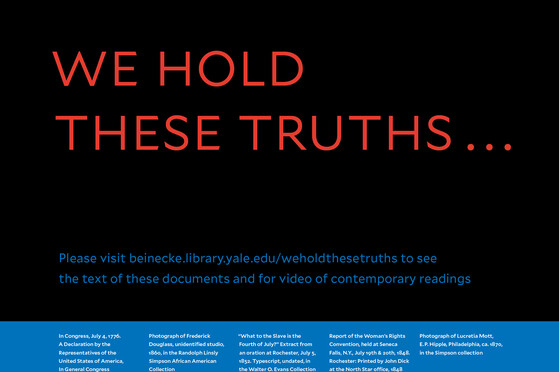Declaration of Independence, 1776
On the north side of the library’s ground floor glass windows (toward Grove Street), all wer welcome to visit and see a reproduction of one of the 26 known copies of the historic first printing of the Declaration of Independence. Often referred to as the Dunlap Broadside in honor of John Dunlap who printed approximately 200 copies in Philadelphia on July 4, 1776, the broadside was soon distributed throughout the thirteen states to announce the establishment of the new nation. (
Beinecke 1977 Folio 13)
In addition to the this large vinyl image of the first printing of the Declaration of Independence, the library windows also showcased reproductions of some other essential documents of the nation’s history:
Frederick Douglass’s Oration, 1852
“What to the Slave is the Fourth of July?” extract from an oration at Rochester, July 5, 1852. Typescript, undated, in the Walter O. Evans Collection of Frederick Douglass and Douglass Family Papers (Beinecke JWJ MSS 240)
Watch a reading of Frederick Douglass’s Oration
(Read by Walter O. Evans, David Blight, Babz Rawls Ivy, and Erik Clemons, recorded in 2020.)
Woman’s Rights Convention, 1848
The Report of the Woman’s Rights Convention, Held at Seneca Falls, N.Y., July 19th and 20th, 1848. Rochester: Printed by John Dick at the North Star Office (i.e., Frederick Douglass’ newspaper office). It includes the “Declaration of Sentiments,” with opening words that declare, “We hold these truths to be self-evident; that all men and women are created equal … “ (Beinecke 2013 13)
Watch a reading of The Declaration of Sentiments
(Read by U.S. Congresswoman Rosa DeLauro, recorded in 2020.)
The library windows also featured reproductions of carte-de-visite images of Douglass from 1860, and of Lucretia Mott, abolitionist, women’s rights activist, and an organizer of the 1848 convention, from 1870.
Other markers of the nation’s founding nearby
American history is alive and accessible throughout New Haven. Visitors are also encouraged to see other markers of U.S. history related to the Declaration of Independence located near the Beinecke Library.
Immediately north of the library, the
Grove Street Cemetery, 227 Grove Street at High Street, is the burial site of Roger Sherman, a signatory of the Declaration and one of the Committee of Five – led by Thomas Jefferson and including John Adams, Benjamin Franklin, and Robert Livingston – charged by the Second Continental Congress with drafting and presenting the Declaration of Independence. The first chartered burial ground in the U.S., the cemetery is free and open to the public daily 9 am – 4 pm.
On July 4, the General David Humphreys Branch of the Connecticut Society of the Sons of the American Revolution, will honor all 56 signers of the U.S. Declaration of Independence and local veterans of the Revolutionary War, at their annual Independence Day ceremony at 9 am. All are welcome to attend.
A few blocks south of the Beinecke Library, the
Yale University Art Gallery, 1111 Chapel Street, holds numerous works of art related to the founding of the nation. The works on view to the public include John Trumbull’s “The Declaration of Independence, July 4, 1776,” a depiction of the Committee of Five presenting the document to John Hancock. Visit the gallery’s website for information about visiting and for links to their digital collections.

